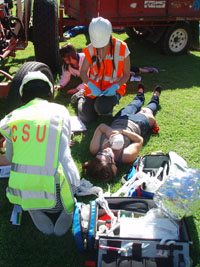 It may come as no surprise that paramedics and firefighters are considered by the Australian public to be the ‘most trusted professions’. Both share the number one position in the Readers Digest 2013 Australia’s Most Trusted Professions poll.
It may come as no surprise that paramedics and firefighters are considered by the Australian public to be the ‘most trusted professions’. Both share the number one position in the Readers Digest 2013 Australia’s Most Trusted Professions poll.Mr Joe Acker, program leader and senior lecturer in paramedics at the School of Biomedical Sciences, at Charles Sturt University (CSU) in Port Macquarie said, “One of the reasons paramedics continue to be one of the ‘most trusted professions’ is the increasing range of non-traditional roles paramedics are now employed in.
“Apart from their traditional ambulance service roles, paramedics are now being trusted with workplace health and safety responsibilities as well as providing emergency and primary health care services for employees working in very remote and dangerous places.
“In heavy industries such as mining, oil, gas, and construction, it is common for employees to work in geographically isolated locations in both developed and developing countries. Remote worksites include offshore oil rigs, mining and construction sites, and natural resource exploration camps.
“There, paramedics are often tasked to provide emergency care and primary health services to employees in environments where they are exposed to unique health risks, including infectious diseases, traumatic industrial injuries, isolation, and the effect of all these factors on stress, mental health, and chronic disease.”
Mr Acker, whose doctoral research is about paramedics who work in industrial settings, notes that there are 11 940 ambulance officers and paramedics identified in the 2011 Australian Bureau of Statistics census. Of these, 88 per cent are employed by State or Territory ambulance services, leaving 12 per cent of paramedics working in private-sector, non-ambulance service roles. Of these 1 426 private-sector paramedics, 213 identified their work environment as ‘mining’ or ‘other industries’.
“While the overall numbers of paramedics engaged in industrial activities are relatively small (1.8 per cent), it is a rapidly growing employment sector,” Mr Acker said. “Between 2006 and 2011 there was a 152 per cent increase in the number of paramedics working in the mining sector and a 43 per cent increase in the ‘other industries’.
 “Clearly, employment opportunities for paramedics are increasing beyond the State and Territory ambulance services. Some of these new employers include private medical transportation companies, humanitarian and non-governmental organisations, the defence forces, and natural resources companies.
“Clearly, employment opportunities for paramedics are increasing beyond the State and Territory ambulance services. Some of these new employers include private medical transportation companies, humanitarian and non-governmental organisations, the defence forces, and natural resources companies.“Australian paramedics are well-suited to these remote industrial sites because their practice has evolved significantly over the past decade, beyond the traditional ambulance response and patient transport to hospital. Today, paramedics are providing primary health services, referrals to other health professionals, an expanded scope of clinical practice, as well as injury prevention and health promotion activities.”
Mr Acker will deliver a free public lecture in Port Macquarie on Wednesday 21 August about advances in emergency medicine. Read ore on CSU News here.
Find out more about the CSU Bachelor of Clinical Practice (Paramedic) here.





Social
Explore the world of social